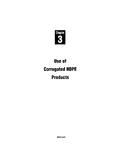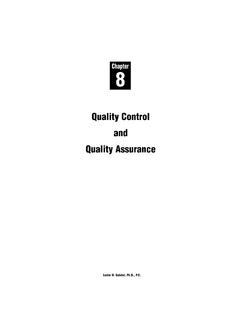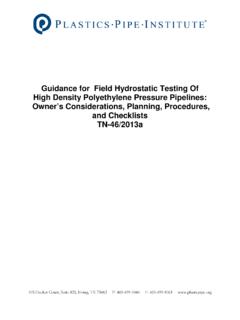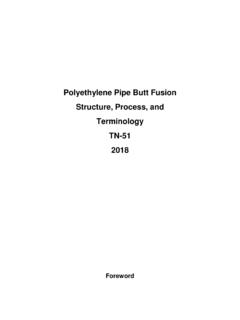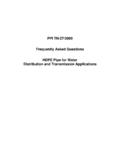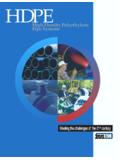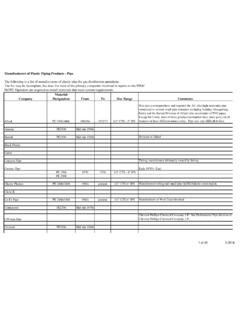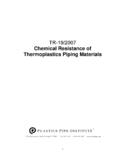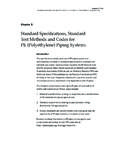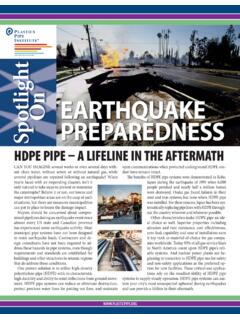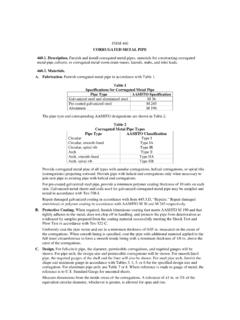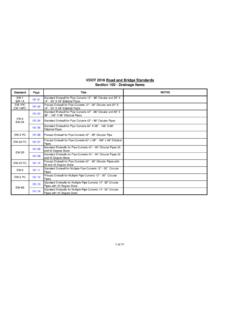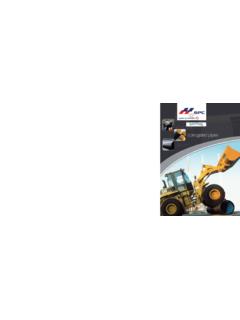Transcription of Recommended Installation Practices For …
1 CORRUGATEDPOLYETHYLENEPIPEASSOCIATIONACP PR ecommendedInstallationPractices For CorrugatedPolyethylene Pipe and FittingsBrought to you by the CPPA, a non-profit industry trade association dedicated to providing unbiased, non-brandedinformation about the use andinstallation of corrugated polyethylene Information ResourceA division of the Plastics Pipe Institute, Inc. Installation4389 Installation Practices 7/24/00 5:10 PM Page 2 PrefaceThe material presented in this technical booklet has been prepared in accordance with recognized principles and Practices , and is for general information only. The informationshould not be used without first securing competent advicewith respect to its suitability for any general or the material is believed to be technically correct,the corrugated Polyethylene Pipe Association makes no representation or warranty of any kind, and assumes no liability therefore.
2 Inquiries on specific products, their attributes, andthe manufacturer s warranty should be directed to membercompanies. An up-to-date directory of the membership of theCorrugated Polyethylene Pipe Association is available on Installation Practices 7/24/00 5:10 PM Page 6 Table of ContentsIntroduction5 Jobsite Receiving and Handling6 Excavation and Backfilling9 Construction Loads17 Compaction Equipment18 Trench Boxes20 Field Modifications and Connections22 System Inspection and Testing26 Summary3044389 Installation Practices 7/24/00 5:10 PM Page 7 IntroductionThis booklet provides information on handling andinstallation of corrugated polyethylene pipe and fittings innonpressure applications including most sewers, culverts,and subdrainage systems.
3 Some specialized nonpressureapplications, such as landfill leachate systems and septictank leach fields, require a more detailed engineeringanalysis and are not discussed here. The information contained in this booklet can be appliedto most corrugated polyethylene pipe. It is not intended tosupersede the manufacturer s instructions, project specifi-cations, or applicable safety safety regulations and guidelines must be observedduring all phases of construction including foundationpreparation, excavation, pipe handling, assembly andbackfilling. These products are solely intended for theconveyance of fluids. Access into this product for maintenance, inspection, or other reason should be donein strict accordance with OSHA recommendations for confined space entry.
4 54389 Installation Practices 7/24/00 5:10 PM Page 10 Delivery InspectionManufacturers make every effort to ensure order accuracy andquality. As a final check, the customer should conduct a personalinspection at delivery to verify that the correct product and theexpected quantity is received. Pipe corrugations, gaskets, pipeends, couplers or other joints, and any accessories should bevisually inspected for damage that may have occurred IdentificationProduct markings on pipe, joints, and accessories may varyslightly among manufacturers. The following information isgenerally included on the pipe: Nominal pipe size Manufacturer s name Date code Applicable standard(s)These markings help make product identification easier for jobsite delivery contractor should set aside an area for products to bestored on site.
5 This area should be flat, free of large rocks,rough surfaces, and debris. It should also be out of the way of construction traffic. Pipe may be delivered either palletized or loose, depending onthe type and quantity of product. Pallets can be unloaded with a backhoe or other piece of equipment, and a nylon sling orcushioned cable. The sling should be wrapped around the pallet at the third points as it lifts the pallet onto the ground. As an alternative to using a sling to unload full pallets, the pallet can be opened and lengths of pipe can be unloaded individually. Non-palletized pipe can be unloaded by carefullyrolling single lengths of loose pipe from the delivery truck ontoa front end loader, and then onto the ground. Alternatively, thepipe can also be lifted using a nylon sling or cushioned cable at the third points.
6 Equipment such as loading booms or forklifts should not be used since they can damage the Figure 1 (following page) for examples of proper handlingduring unloading. Jobsite Receiving and Handling64389 Installation Practices 7/24/00 5:10 PM Page 11 Figure 1: Pipe HandlingIndividual Lengths of PipePalletized ProductItems such as coupling bands, fittings, and accessories arepackaged in different ways depending on the product, quantity,and size. They should be unloaded in a safe manner that willnot cause damage. Jobsite StoragePalletized pipe should remain in the pallet for jobsite pipe can be stockpiled for temporary storage in a flat debris-free area out of the way of construction the stockpile with secured timbers spaced the width ofthe proposed stockpile, at a distance not exceeding the thirdpoints.
7 For pipe with attached bells, a common stackingmethod is to alternate the direction of the pipe lengths so thatthe bells are not stacked on each other. As shown in Figure 2,up to three pipes can be laid before alternating layers should follow the same pattern as the firstbut with fewer sticks of pipe in each block. For smooth interiorpipe, the storage space can sometimes be minimized by nestingsmaller diameters inside larger diameters. Factory installedgaskets on the spigot can be protected by positioning thembetween pipe corrugations. Nesting corrugated interior pipeshould only be done when the pipe can be removed easily. 74389 Installation Practices 7/24/00 5:10 PM Page 14 Figure 2: Stockpiling for Bell-and-Spigot Pipe (First Layer)1/3 Pipe LengthA reasonable amount of care in handling the pipe should betaken during stockpiling.
8 The pipe should not be dropped,dragged, or bumped against other pipe or objects, or climbedon. Stockpile heights should be limited to approximately 6' (2 m) so that the pipe can be handled easily and safely manually. Other items, such as coupling bands, fittings, gaskets, and accessories, should be stored in a convenient area awayfrom construction traffic, protected from damage and may provide specific instructions for the handling of these items. A few safety precautions should be taken during jobsite storageand stockpiling. While small diameter pipe and lightweightaccessories can generally be handled manually, large diameterpipe requires equipment, such as a backhoe, with a nylon slingor cushioned cable wrapped around the third points for safehandling.
9 Heavy fittings, as an example, should also be carefullyhandled with equipment. Stockpiles should not be climbed on jobsite conditions and safety regulations, othersafety precautions may also need to be followed. Stringing the PipePlacing the pipe and accessories along the open trench, or stringing, can save handling time. Each pipe length shouldbe laid on a level surface as near as possible to the trench onthe side opposite the excavated trench material; allow somespace between pipe to protect pipe ends. The pipe should beout of the way of any equipment in a location that will allowexcavation to proceed uninterrupted. 84389 Installation Practices 7/24/00 5:10 PM Page 15 All types of pipe must be installed as specified to performas expected. This section describes the Installation method generallyused for corrugated polyethylene pipe designed in accordancewith the CPPA technical booklet Structural Design Method forCorrugated Polyethylene type of backfill material andcompaction requirements must be determined during designand are not discussed in detail in this section.
10 Other requirementsmay be called out in contract documents. Furthermore, additionalguidelines for the Installation of corrugated polyethylene pipeare located in the following standards: ASTM D2321 - Standard Practice for Underground Installation of Thermoplastic Pipe for Sewers and Other Gravity-Flow Applications CAN/CSA - Recommended Practice for the Installation of Thermoplastic Drain, Storm and Sewer Pipe and FittingsTrench ExcavationAccording to ASTM D2321, the trench width should be nowider than what is required to safely place and compact, if necessary, the backfill material on either side of the width will depend on the backfill material, compactionmethod, and the pipe diameter. The width of a contractor s available excavator buckets mayaffect trench widths.
